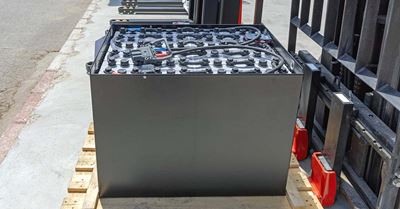Powering Progress: Navigating the Choice Between Lead Acid, Lithium-Ion, and Hydrogen Fuel Cells for Raymond Electric Forklifts

Compare lead acid, lithium-ion, and hydrogen fuel cells to find the best power source for your Raymond electric forklifts and boost efficiency, uptime, and ROI.
In today’s high-velocity warehouse environment, the heart of productivity is beating faster than ever. As e-commerce expands and customer expectations climb, efficiency is no longer just about moving pallets, it’s about making every lift, shift, and recharge count. The power source you choose for your Raymond electric forklifts isn’t just a technical detail, it’s a strategic decision that can dramatically impact your operation’s bottom line.
The Old Guard: Lead Acid Batteries
For decades, lead acid batteries (LABs) have served as the workhorses of warehouse power. They’re well-understood, relatively inexpensive upfront, and can withstand tough environments. Yet, their time-honored status comes with strings attached:
-
Labor and Downtime: LABs require regular watering, cleaning, and scheduled equalization. Battery swaps are routine and each changeout means 10–15 minutes lost per forklift, not to mention detours through busy warehouse space.
-
Performance Fade: As LABs discharge, their power output diminishes, making end-of-shift hours sluggish, both for truck and operator.
-
Charging Constraints: These batteries demand long charge and cool-down times, often dictating two to three batteries per forklift to support multi-shift operations.
The numbers are telling: LABs commonly offer a service life of 1,000–1,500 charge cycles and require significant infrastructure for charging and maintenance. While initial outlay is lower, hidden costs in labor and productivity are substantial over time.
The Challenger: Lithium-Ion Batteries
Lithium-ion batteries (LIBs) have rewritten the rulebook for forklift power, offering warehouse managers a potent combination of performance, efficiency, and operational savings:
-
Consistent Power, Shift After Shift: LIBs deliver full performance from full charge to empty, no afternoon slowdowns.
-
Minimal Maintenance: These batteries are sealed, maintenance-free, and require neither watering nor acid checks. Battery rooms are often unnecessary with new installations, opening up valuable space.
-
Faster Charging & Opportunity Charging: LIBs can be recharged in under two hours and readily support “opportunity charging”, or quick top-ups during breaks or shift changes. This makes single-battery-per-truck operations practical, dramatically reducing downtime and labor costs.
Field data is compelling. Raymond’s study at a food storage warehouse found that converting from LAB to LIB resulted in a 17% productivity improvement and reduced total operational hours by over 10% for comparable workloads. The cumulative return on investment? Between 415% to 656% over a six-year span, with breakeven points typically hit within 10–16 months in both fleet-wide and phased adoption models.
|
Feature |
Lead Acid Battery |
Lithium-Ion Battery |
|
Service Life (cycles) |
1,500 |
3,000–5,000 |
|
Full Charge Time |
8–10 hours |
1–2 hours |
|
Maintenance Needs |
High |
Minimal |
|
Performance Consistency |
Drops as discharges |
Steady |
|
Upfront Cost |
Low |
Higher |
|
Total ROI |
Lower |
Significantly Higher |
For high-throughput, multi-shift environments, particularly where every saved minute means dollars, LIBs are quickly becoming the preferred solution.
The Contender: Hydrogen Fuel Cells
Hydrogen fuel cells sit at the frontier of sustainability and rapid refueling, promising the benefits of electric forklifts alongside the ability to “fuel up” in minutes:
-
Zero Emissions: Hydrogen fuel cells emit only water vapor, appealing to operations focused on sustainability.
-
Minimal Downtime: Refueling takes a few minutes, sidestepping the long charge cycles of LABs.
-
Suits Large Fleets: The high infrastructure costs for hydrogen are best absorbed by large operations (typically 50+ units).
Real-world economics, however, temper their appeal. Hydrogen infrastructure carries a significant upfront burden, which is amortized only in large, multi-shift fleets. For fleets under 50 units, a category encompassing roughly 80% of warehouse operations, the cost of hydrogen fueling infrastructure is rarely justifiable. Additionally, the price of hydrogen fuel remains volatile; running costs tend to outpace those of battery-powered solutions unless fuel prices drop further.
Total Cost of Ownership: The Big Picture
Choosing the right power source requires balancing direct costs with hidden ones: maintenance, downtime, labor, and facility overhead. Here’s how key options stack up for Raymond forklifts:
Lead Acid Batteries
-
Lower initial investment.
-
Higher lifetime maintenance, labor, and downtime costs.
-
Best fit for single-shift, low-utilization applications.
Lithium-Ion Batteries
-
Higher upfront cost, rapidly offset by labor and productivity gains.
-
Little to no maintenance, consistent performance.
-
Top pick for multi-shift or high-velocity operations with limited space.
Hydrogen Fuel Cells
-
Most attractive in very large, multi-shift fleets where downtime can’t be tolerated.
-
Significant capital costs for infrastructure and ongoing hydrogen supply.
-
Environmentally compelling, but not always cost-competitive for smaller fleets.
Making Your Move: Factors to Consider
As you weigh your options, reflect on your warehouse’s specific needs:
-
How many shifts do you run? More shifts favor LIB or hydrogen.
-
Are labor shortages and rising costs a concern? Battery maintenance and changeout labor may add up quickly.
-
Do you need flexibility to phase in upgrades, or are you building a new facility?
-
Is sustainability a core priority for your operation?
Above all, pay attention to total cost of ownership, not just sticker price. The right decision often positions your warehouse for years of hidden savings and operational agility.
Ready for the Next Step?
With the landscape of material handling power evolving rapidly, partnering with experts is essential. Raymond West offers a holistic approach, from assessing your current fleet to designing, deploying, and supporting energy solutions tailored for your operation’s challenges. If you’re considering next-generation forklift power sources or planning a move toward automation, reach out to Raymond West. It’s time to take the next confident step toward a more productive and profitable warehouse.

